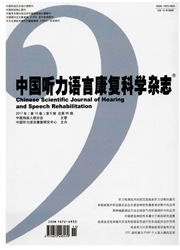

 中文摘要:
中文摘要:
目的分析外伤所致传导性耳聋的症状体征、听力学表现及影像学特点,总结诊断要点和手术治疗效果。方法回顾性分析解放军总医院2008年1月~2011年3月收治的具有明确外伤史、鼓膜完整的传导性听力下降患者20例。每位患者均进行详细病史询问、临床检查、听力测试和影像检查。行鼓室探查术,根据患者听骨链损伤的不同类型,行听骨链重建术。术后1~3个月复查纯音听力,比较术前和术后的纯音听阈,总结分析手术治疗效果。结果本组20例患者,手术探查听骨链发现砧骨移位14例,包括砧镫关节脱位、锤砧关节分离以及二者兼具的听骨链损伤,锤骨移位且粘连固定2例,镫骨足弓骨折2例,砧骨长脚骨折1例,镫骨底板自前庭窗脱出1例;其中3例砧骨移位患者术中可见面神经明显水肿。根据鼓室探查情况行相应的听骨链重建术,15例行自体听骨雕凿后的听骨链重建术,1例行砧镫关节复位术,4例行人工听骨植入术,3例合并面瘫患者行听骨链重建术的同时行面神经减压术。术后1~3个月随访,患者自觉听力提高,纯音测听示言语频率内气导平均听阈恢复至30±11dB,平均气骨导差为18±10dB。伴有面瘫患者的面神经功能恢复至HB I 级。结论有外伤史的患者如有听力下降,应行全面细致的耳科检查、听力学检查和高分辨颞骨CT扫描,如纯音测听气导听阈下降且存在明显的气骨导差,或颞骨CT显示听骨链形态异常,应考虑系听骨链中断引起的传导性耳聋。应根据听骨链损伤的不同类型,重建听骨链,恢复患者听力,合并面瘫者,同时行面神经探查减压手术。
 英文摘要:
英文摘要:
objective To analyze the medical, audiological and imaging features of trauma induced conductive hearing loss,to summarize the key diagnostic points and to observe the effects of surgical treatment. Methods Twenty patients with intact tympanum but a history of head injuries were retrospectively reviewed. Through history taking, clinical examination and audiological and imaging examinations, 20 patients were diagnosed with conductive hearing loss. Ossicular chain reconstruction was performed on each patient based on the types of injury. The patients received the pure-tone audiometry (PTA)1-3 monthsfafter operation.The preoperative and postoperative pure-tone thresholds were compared to judge the effects of surgical treatment. Results The surgical exploration revealed 14 cases of incus displacement, including incudostapedial joint dislocation, incudomalleolar joint dislocation or both injuries, 2 cases of malleus displacement and fixation, 2 cases of stapes fracture, 1 case of the lenticular process of incus fracture and 1 case of stapes displacement. Three cases of incus displacement showed facial nerve edema. Different types of ossicular reconstruction were performed according to the exploration results: 15 cases with autogenous auditory ossicle remodeling, 1 case with incudostapedial joint reduction, 4 cases with artificial auditory ossicle implanting and 3 cases with facial nerve decompression and ossicular reconstruction. After the operation, 20 patients felt that their hearing was improved. The mean postoperative pure-tone threshold was 30±11 dB HL and the mean ABG was 18±10 dB HL while the mean preoperative pure-tone threshold was 55±10 dB HL and the mean ABG(air-bone-gap) was 40±8 dB HL. The facial nerve functions of 3 cases with facial paralysis recovered to House-Brackmann Grade I three months after receiving facial nerve decompression. Conclusion The patients with a post-traumatic hearing loss should undergo a comprehensive medical examination, audiological evaluation and HRCT of temporal b
 同期刊论文项目
同期刊论文项目
 同项目期刊论文
同项目期刊论文
 期刊信息
期刊信息
